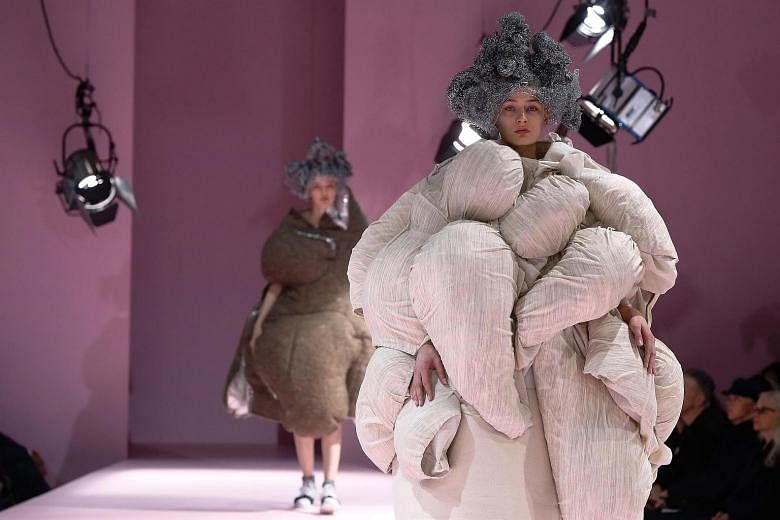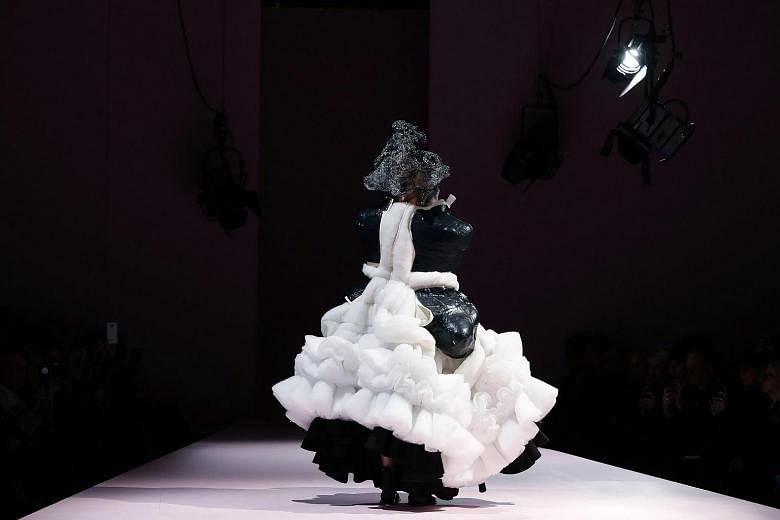PARIS (NYTimes) - Being only the second living designer to be selected for a solo show at the Metropolitan Museum of Art's Costume Institute is the kind of thing that can put a lot of pressure on a girl. Even if she is Rei Kawakubo, the famously abstruse and oracular 74-year-old founder of Comme des Garcons.
This is particularly true during Fashion Week, if she happens to be holding a show, as Kawakubo did here on Saturday (March 4).
First, there are all those people who suddenly come out of the woodwork and want to attend your fashion show, because it is two months before the big museum exhibition, even if they had never appeared all that interested before - about two or three times as many as normal, according to Kawakubo's husband, Adrian Joffe. (Tant pis; she kept the seats to the usual 300 or so.) Second, there is the presence of the Met - and Met Gala - crew in the front row: Andrew Bolton, the institute's curator in charge; Anna Wintour, a co-chairwoman of the gala (and editor of Vogue); and Catherine Martin, costume designer, an occasional Met collaborator and wife of film director Baz Luhrmann.
And third, there is the unavoidable understanding that everyone watching is going to be thinking, on some level: Is this art? Does it merit inclusion in the museum? Is this going in the show? Will that dress be on display opening night, or maybe worn by Gisele Bundchen or Katy Perry, the gala's hosts this year?
As far as the last question goes: Not likely. Mostly because what Kawakubo showed, on a blush pink runway, in front of a blush pink scrim, was kind of a sly riposte to the red carpet. One that took the standard female silhouette - the kind that tends to be celebrated and shown off at just such gala moments - and distorted it into a series of expansive, bulbous curves. Just not in the places you might expect.
Using materials taken from construction rather than closets (at a guess: insulation, cotton wadding, rug liners, paper bags and wallpaper) Kawakubo began with a basic dress carapace in the shape of classical statuary - after the arms had fallen off. Puffed shoulders slid backwards onto shoulder blades; breasts moved down and to the side; rolls of sleeves sprouted from skirts.
One dress looked as if it were covered in seed pods; two more resembled a Fausto Melotti sculpture (also geese in profile). Another curved over the head, so the face poked out beneath. Like Little Red Riding Hood, if her cape, instead of the wolf, had tried to swallow her.
In them, the women circled one another questioningly on the runway, in an ebb and flow of recognition and alienation. What is that body over there?
It is a favored axiom of fashion to say there is a limit to what designers can do because they are restricted by the exigencies of a garment: a hole for the head; two for each arm; one for the body. Kawakubo has never had truck with any of that. At least not when it comes to her shows. In her shops, she has plenty of clothes you can wear. On her runways, she has pieces that make you think. (And outfits were paired with customised Nike Flyknits, so even if the models couldn't wave their arms, they could walk.) It doesn't happen that often. At least not in a way that challenges assumptions and prejudice. That is why she is at the Met.





